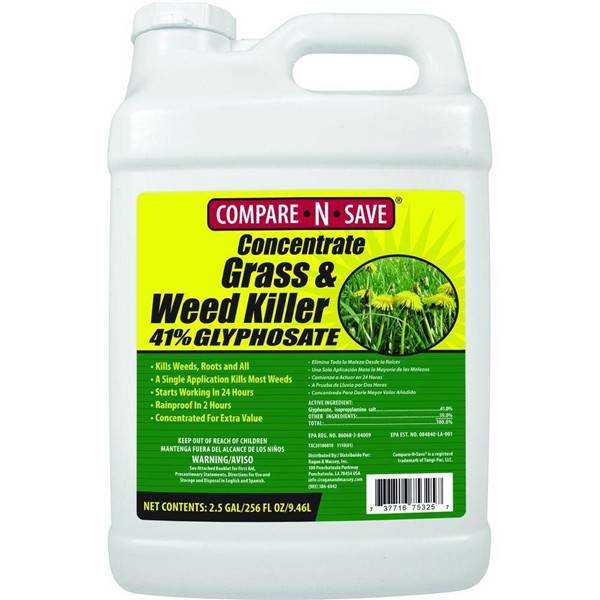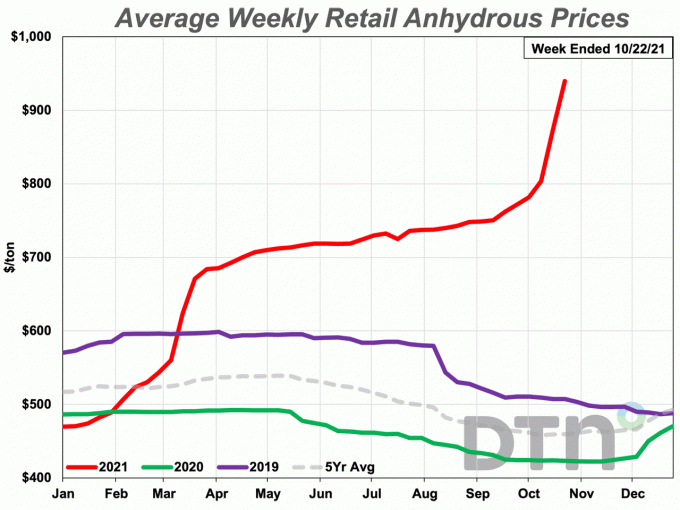December 17, 2025 | 11:59 GMT +7
December 17, 2025 | 11:59 GMT +7
Hotline: 0913.378.918
December 17, 2025 | 11:59 GMT +7
Hotline: 0913.378.918

Weed killer. Photo: Getty
Farmers are already preparing for added costs to grow a crop next year, but even today’s prices may be an accurate snapshot for 2022 potential budgets. That’s because input prices continue to climb by the day.
From nitrogen to glyphosate, prices are posting 100% to 300% increases right now. Some farmers say they can’t even get retailers to price product until the inputs actually arrive at the retail facilities.
One retail location in Missouri told Farm Journal glyphosate prices are up 100% this year, going from $19 per gallon to $38 per gallon. And glufosinate is showing a 50% increase, now at $70 per gallon compared to $45 last year.
However, in northeast Iowa, glyphosate prices have shot up 294%. What cost the farmer $17 per gallon last year, is now showing a price tag of $50 per gallon.
In northwest Indiana, glyphosate prices have seen a 300% increase in some locations, now at $80 per gallon.
“I presume farmers are looking ahead and if they're worried about higher prices, trying to lock in inputs now at prices they think are more reasonable,“ says Joseph Balagtas, associate professor of Agricultural Economics at Purdue University. “And to the extent that we have high commodity prices forecast in the next year, trying to lock in those high commodity prices, the real pinch would be is if you're locked into high prices, and something happens to the market, demand falls and we're looking at low commodity prices next year with high input costs. I think trying to lock in your margins now would make a lot of sense."
Fertilizer Prices Soar
Fertilizer prices are on a steep climb, as well. Stone X Group says the Midwest wholesale anhydrous ammonia prices have risen approximately $434 since Sept. 10. That marks a 65% increase in just over a month, or $72 a week.
One farmer told Farm Journal he priced anhydrous ammonia last week. For a fall application prices currently sit at $1,250 per ton. Just this past spring, prices were $580 for prepay or $650 to $675 per ton for in-season purchases. He was told by this spring, prices could reach $1,400 per ton.
Extreme weather, combined with an energy crunch in China and Europe, are creating rising fertilizer prices around the globe. Higher natural gas prices are adding to the situation, as the issues just keep piling up.
Bloomberg reported last week that Chinese fertilizer cargoes were loaded and ready to for export, but were being held up as local authorities make additional checks.
Push to Produce More in the U.S.?
The U.S. is one of the top fertilizer importers in the world. So, could this supply crisis cause the U.S. to build more domestic plants? Josh Linville of StoneX says the idea may be a stretch.
“When you look at it from a nitrogen sector, these world-scale plants cost billions to build and they take years to do so,” he says. “The last one that was built had a lot of issues coming online. So, even if we decided today, yes, I want to build something in the U.S. marketplace, you're not going see it come online before 2025.”
Linville points out even if a company started the process today, the U.S. isn’t the least expensive place when it comes to energy costs. Instead, the cheapest energy providers are countries that lack stability.
“Cheap energy is found in places like Venezuela, Iran and Russia, countries you don't exactly want to go sit billions of dollars in,” he adds. “That story has been told before and I don't think anybody wants to repeat it."
Fight to Find Fertilizer
As fertilizer prices near the 2008 highs, this rapid rise in input prices is being driven by a supply crunch, not demand like the U.S. saw in 2008.
Currently, rising input costs could eat into 2022 budgets, but acreage decisions may be based on what inputs are available, not necessarily price.
“Somewhat surprisingly, both corn and soybeans were profitable this year, but corn was actually more profitable than soybeans in 2021,” says Michael Langemeier, Purdue University ag economist and a co-author of the monthly Purdue CME Ag Economy Barometer. “Looking at 2022, it's about even. There really is no advantage towards corn or soybeans, despite the fact that nitrogen prices have increased substantially.”

Anhydrous cost a farmer $940 per ton on average during the third week of October, a 22% increase in the past month. The nitrogen fertilizer is now 122% more expensive than last year. DTN chart
Retail fertilizer prices continue to skyrocket into historical price ranges the third week of October 2021, according to sellers surveyed by DTN. All but one of the eight major fertilizers had price increases of 10% or more compared to last month.
Leading the way higher is urea, which was up 26% compared to last month. The nitrogen fertilizer had an average price of $735 per ton.
Anhydrous was up 22% compared to the prior month. The nitrogen fertilizer had an average price of $940/ton. It's the first time anhydrous crossed the $900/ton level since the fourth week of November 2008. That week, the price was $946/ton.
UAN28 is 18% more expensive looking back to last month. The fertilizer has an average price of $451/ton. UAN32 wasn't up quite as much at $492/ton, 13% more than a month ago.
Potash is up 15% compared to last month and has an average price of $716/ton.
DAP was 14% more expensive than last month with an average price of $810/ton. DAP crossed the $800/ton level for the first time since the first week of December 2008. That week, the price was $813/ton.
MAP was 10% higher and had an average price of $863/ton.
The remaining fertilizer, 10-34-0, was 4% higher compared to last month. DTN designates a move of 5% or higher as a significant increase or decrease. The starter fertilizer had an average price of $659/ton. That's still $200/ton more than what farmers paid at this time last year.
On a price per pound of nitrogen basis, the average urea price was at $0.80/lb.N, anhydrous $0.57/lb.N, UAN28 $0.81/lb.N and UAN32 $0.77/lb.N.
Rising fertilizer prices could be affecting which crops farmers plant, not only in North America but also in South America, specifically Brazil.
Dow Jones reported last week increasing fertilizer costs appear to be affecting planting of Brazil's corn crop. The scope of this situation, however, remains unclear.
Arlan Suderman of StoneX said there are already unconfirmed reports of fertilizer shortages in Brazil.
"Those shortages may become more pronounced, though, as we move into 2022 if we remain on the same trajectory," Suderman said.
Dow Jones also reported higher fertilizer prices are affecting European plantings and may pressure the decisions of U.S. farmers if these higher nutrient prices continue.
While there are no easy answers for farmers in the current market, there are important questions to ask. DTN Staff Reporter Emily Unglesbee outlines them here: .
Retail fertilizer prices compared to a year ago show prices for all fertilizers have increased significantly.
10-34-0 is now 45% more expensive, MAP is 81% higher, DAP is 82% more expensive, UAN32 is 97% higher, urea is 105% more expensive, UAN28 is 115% higher, potash 116% is more expensive and anhydrous is 122% higher compared to last year.
(Agweb; DTN)

(VAN) 2025 AQUASTAT Water Data indicates that pressure on freshwater resources is growing as demand increases in regions of scarcity.

(VAN) Planet-warming pollution rates exploded after the end of World War II. James Watt’s steam engine launched the Industrial Revolution in 1769.

(VAN) The British Department for Environment, Food & Rural Affairs (Defra) has amended and extended a derogation for organic poultry and pigs, which currently allows up to 5% non-organic protein in feed.

(VAN) The Ah Louis Store in San Luis Obispo, California, turns into a winter wonderland every holiday season.

(VAN) Japanese feed millers are increasingly incorporating corn into their rations, in response to sustained high rice prices, according to a recent Grain and Feed Update from the Foreign Agricultural Service (FAS) of USDA.

(VAN) The event calls for urgent action to preserve glaciers, and recognises Mountain Future Award-winning projects in Colombia, Kyrgyzstan and Pakistan that protect mountain ecosystems and build resilience.

(VAN) New evidence shows that the health impacts of the Industrial Revolution varied more widely than previously believed, challenging the longstanding narrative that rural communities remained comparatively untouched.